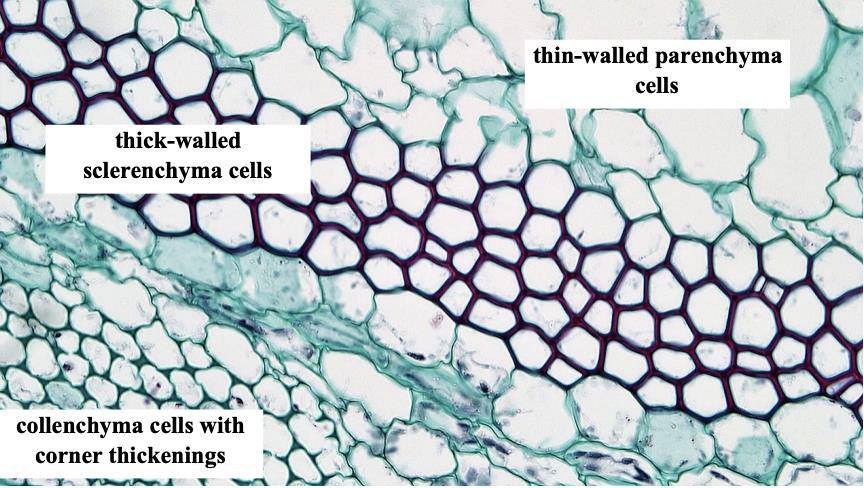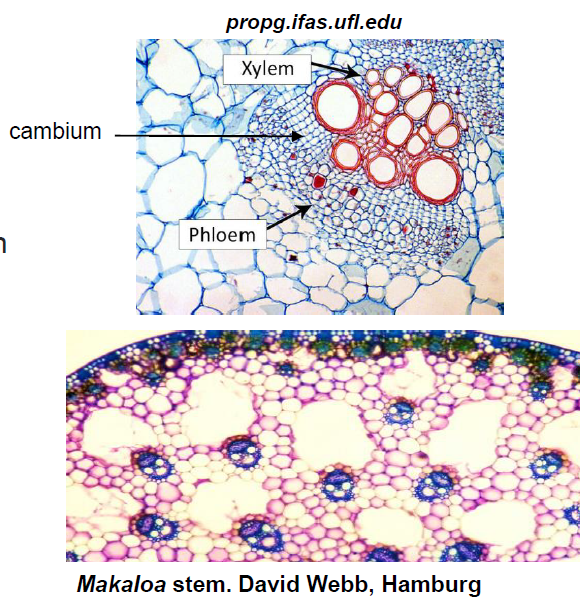lecture 1 - plant cells and tissue systems
1/59
There's no tags or description
Looks like no tags are added yet.
Name | Mastery | Learn | Test | Matching | Spaced |
|---|
No study sessions yet.
60 Terms
what are the main organ systems in vascular plants?
root system
shoot system
name the primary plant organs.
roots
stems
leaves
list the hierarchical organization levels of vascular plants from largest to smallest
systems (root and shoot)
organs
tissues
specialized cells
true or false: all plant structures can be understood by studying just one level of organization
false - plant structures must be studied at multiple levels (systems, organs, tissues, and cells) to understand their complete function and development
explain how the hierarchical organization of vascular plants contributes to their diversity and function
organization at multiple levels (systems, organs, tissues, cells)
specialization at each level
variation in anatomy and chemical composition
what are the primary tissue types in vascular plants?
meristematic tissue
ground tissue
vascular tissue
dermal tissue
what are the two main categories of plant tissue?
permanent tissues
simple tissues
collenchyma
sclerenchyma
parenchyma
complex tissues
vascular tissues: xylem and phloem
epidermis
meristemic tissues
apical meristems
lateral meristems
adventitious (?)
intercalary meristems
list the three types of simple tissues that function as ground tissues
parenchyma
collenchyma
sclerenchyma
what are the main functions of ground tissues?
photosynthesis
support
storage
identify the key characteristics of parenchyma cells
thin primary cell walls (usually lignified)
contain nucleus, cytoplasm, and vacuoles
involved in photosynthesis, storage, and local transport

identify the key characteristics of collenchyma cells
alive at maturity
thickened cell wall (usually unlignified)
primary wall stains dark pink-purple with toludine blue )
provides support and protection

identify the key characteristics of sclerenchyma cells
contain fibers and sclerieds
normally dead at maturity
thickened primary and secondary cell walls (usually lignified)
cell wall stains blue/blue-green with toludine blue O
provides support and protection from microorganisms

compare the three different types of simple tissues under a microscope

what is xylem?
the first of three types of complex tissues
transports water, minerals, and signaling molecules
cell types: tracheids, vessels, fibers, and parenchyma
heavily lignified secondary cell walls, often dead at maturity

what are the different types of cells found in xylem?
tracheids and vessels
xylem parenchyma
tyloses
fibers
what are the characteristics of tracheids and vessels in their initial and mature states, and how do secondary cell wall thickenings contribute to their function?
initial state: un-lignified and alive during development
mature state: highly lignified (rigid and strong) and typically dead, allowing efficient water transport
secondary cell wall thickenings: vary to reflect the maturity and functional needs of the xylem
provide structural support and prevent collapse under the pressure of water transport
what is the function of tracheids and vessels?
essential for water conduction, divided into protoxylem (early xylem) and metaxylem (mature xylem)
what is the function of xylem parenchyma?
storage and lateral transport within the xylem
what is the function of tyloses?
outgrowths of parenchyma cells, involved in blocking damaged vessels during injury or infection
what is the function of fibers?
provide mechanical support
what is phloem?
the second of three types of complex tissues
vascular tissue developed from procambium
transports sugars (i.e. fixed carbon) and signaling molecules (metabolites)
what are the main cell types found in the phloem of angiosperms?
sieve elements (or sieve tube members): specialized for nutrient transport, lack nuclei at maturity, rely on companion cells for support
parenchyma cells: include companion cells, which provide metabolic support to sieve elements
fiber cells: provide structural support
how do the phloem cell types in gymnosperms differ from those in angiosperms?
gymnosperms lack true sieve tube members and companion cells. instead, they have:
sieve cells: more primitive than sieve tube members
albuminous cells: function similarly to companion cells in angiosperms
what is the epidermis?
the third of three types of complex tissues
outermost layer; functions include protection, gas exchange regulation, transpiration, secretion and structural roles
specialized cells: trichomes, guard cells, root hairs
what are trichomes?
specialized epidermal cells that extend from the plant surface, forming hair-like structures for protection, secretion, or other specialized functions
what are guard cells?
specialized epidermal cells that regulate gas exchange and transpiration by controlling the opening and closing of stomata
what are root hairs?
specialized extensions of root epidermal cells (trichoblasts) that increase surface area for water and nutrient absorption
explain the concept of modular development
plants grow through repetitive addition of similar units, aiding repair and reproduction
how can plant growth be classified?
indeterminate
determinate
what is indeterminate growth in plants and where is it found?
found in most stems and roots
produces parts that can grow for variable periods of time
size and shape vary depending on local environment
growth pattern is flexible and responsive to conditions
what is determinate growth in plants and where is it found?
found in flowers and most dicot leaves
produces parts with predictable size and form
results in fixed, predetermined structures
growth pattern is more strictly controlled
what are the two main processes involved in plant growth and development?
cell division
cell expansion/elongation (responsible for most size increase)
how do plant cells differ from animal cells in terms of mobility?
plant cells are largely immobile
their position is fixed due to cell walls
this immobility makes positional signals crucial for development
what role do positional signals play in plant cell development?
organize cells spatially
determine cell fate
guide tissue development
crucial for proper organ formation
increase in plant size is often more dependent on _____ than on cell division
elongation/expansion
compare and contrast simple and complex permanent tissues in plants
simple tissues
composed of similar cell types
primarily function in ground tissue roles (photosynthesis, support, storage)
include collenchyma, sclerenchyma, and parenchyma
complex tissues:
composed of multiple cell types working together
specialized for specific functions like transport (xylem and phloem) or protection (epidermis)
more structurally and functionally sophisticated than simple tissues
what is the key characteristics of meristematic tissues?
they are undifferentiated (i.e. they continue to divide and contribute to plant growth)
what are apical meristems?
regions of cell division at the tips of roots and shoots
consist of SAM (shoot apical meristem) and RAM (root apical meristem)
specified early in embryo development
responsible for elaborating adult plant structure
involved in reproductive transition
what are lateral meristems?
responsible for secondary growth
increase plant girth
include vascular cambium and cork cambium
form axillary and lateral root meristems
what are adventitious meristems?
arise ectopically from differentiated tissues
typically form shoot meristems
provide alternative growth points
enable plant regeneration
what are intercalary meristems?
found in plants without secondary meristems (monocots)
enable regrowth after cutting
may be involved in indeterminate leaf growth
important for grass regeneration
true or false: monocots typically exhibit secondary growth.
false
explain how different types of meristems contribute to plant growth and development
different meristems work together to enable plant growth:
primary meristems (SAM and RAM) establish basic plant architecture
lateral meristems enable secondary growth and increase in girth
adventitious meristems allow for recovery and alternative growth
intercalary meristems enable continued growth in monocots
this diverse set of meristems allows plants to:
maintain continuous growth throughout life
repair damage
adapt to environmental conditions
develop complex structures from simple beginnings
what is the primary function of the vacuole in plant cells?
regulates turgor pressure
stores resources and isolates waste
facilitates cell elongation and growth
what is the tonoplast?
a selectively permeable membrane that surrounds the vacuole in plant cells. it controls what enters and exits the vacuole, helping regulate:
turgor pressure
cell pH
storage of nutrients and waste products
ion concentrations
what are transvacuolar cytoplasmic strands and their key features?
strands that cross through plant cell vacuoles
supported by internal actin filaments
work with microtubules during cell division
serve as distribution routes for organelles and metabolites
contain moving golgi and ER for secretion systems
dynamic structures that can appear and disappear
what structures move through cytoplasmic strands?
organelles
metabolites
golgi apparatus
endoplasmic reticulum (ER)
secretory vesicles
what is the role of cytoplasmic strands in cell division?
work together with microtubules
help organize cellular components
assist in formation of phragmosome
aid in preprophase band formation
facilitate organelle distribution during division
name the specialized plastids and their functions.
proplastids: progenitors of other plastids (colourless w/o distinctive morphology)
chloroplasts: photosynthesis
chromoplasts: pigment storage
leucoplasts: synthesis of starch, lipids, and proteins
amyloplasts: starch storage
what are the three main layers of the plant cell wall? (note: in order of formation)
middle lamella: forms first between adjacent cells
primary cell wall: thin and flexible, allows for expansion
secondary cell wall: forms inside primary wall after full expansion
what is the middle lamella?
first layer to form between adjacent cells
connects neighboring cells together
contains mostly pectin
important for cell adhesion
what are the characteristics of the primary cell wall?
relatively thin and flexible
allows for cell expansion
contains cellulose microfibrils
includes hemicellulose
contains pectin and proteins
what is the secondary cell wall?
forms inside the primary wall
develops only after cell has finished expanding
typically thicker than primary wall
often contains additional layers
provides additional strength and support
what are the main components visible in plant cell wall structure?
cellulose: strong fibers that provide structural support and tensile strength
hemicellulose: cross-links cellulose fibers and adds flexibility
pectin: enables cell adhesion and wall flexibility
proteins: provide enzymatic activity and structural support
plasma membrane: selective barrier between cell wall and cytoplasm
why are plasmodesmata essential for plants?
mosaic of symplastically (via cytoplasm through plasmodesmata) connected cells
enable cell-to-cell communication
allows regulated movement of molecules between cells
creates continuity in plant tissues
what is the cytoplasmic sleeve and its function?
channel within plasmodesmata
allows regulated movement of larger molecules
provides pathway for symplastic connection
controls molecular transport between cells
what types of molecules can pass through plasmodesmata?
smaller molecules (ions, sugars, amino acids) pass freely
some small proteins like GFP can pass through
larger proteins (>10kDa) are regulated or prevented
nucleic acids have limited movement
what are the two types of plasmodesmata and how do they form?
primary plasmodesmata: formed during cell division when ER gets trapped across middle lamella
secondary plasmodesmata: form between mature cells after cell wall formation
how do plasmodesmata compare to animal cell gap junctions?
have limited functional similarity
both transport small molecules
plasmodesmata are more complex structurally
plasmodesmata have more diverse transport capabilities
gap junctions are simpler channels
explain how plasmodesmata contribute to plant cell communication
establish a symplastic continuum throughout plant tissues while enabling selective transport of different sized molecules between cells
structures are crucial for regulating cell-to-cell communication and maintaining proper tissue organization
enable plants to coordinate their responses to various signals
their formation both during cell division and between mature cells ensures continuous cellular connectivity throughout plant development